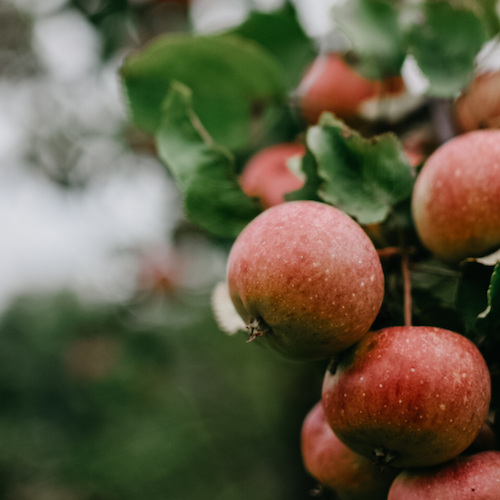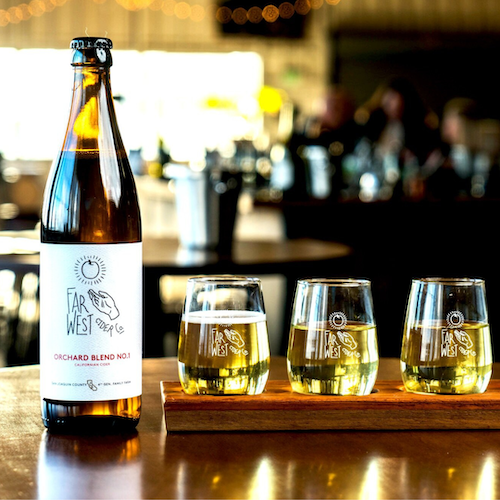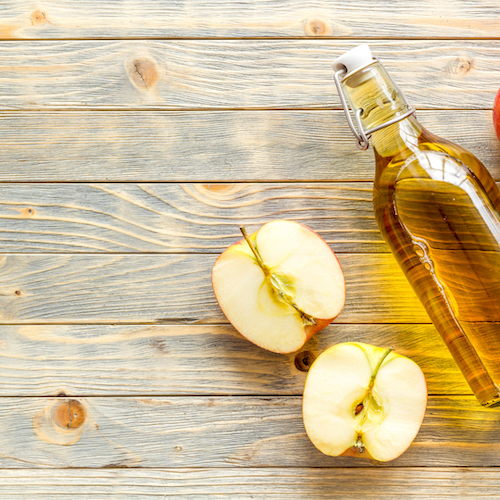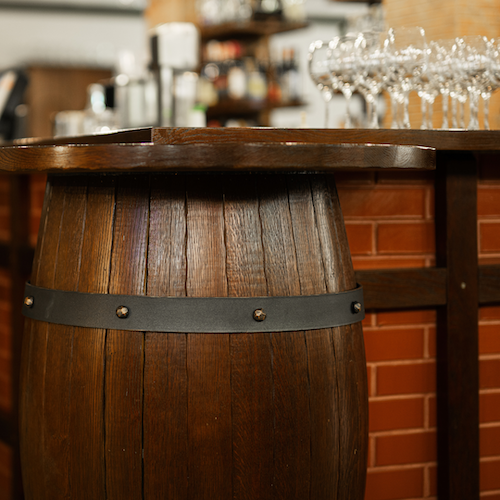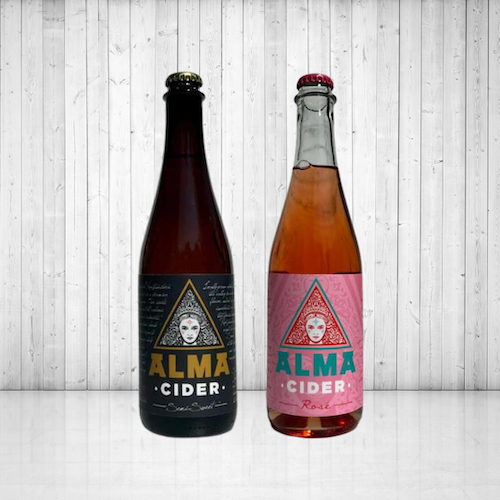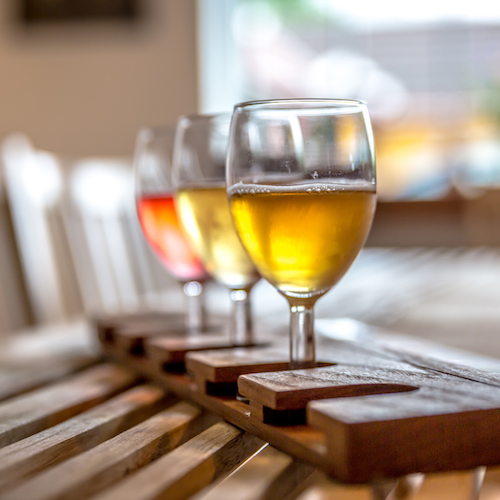Archive for July 2023
2023 Apple Crop Outlook
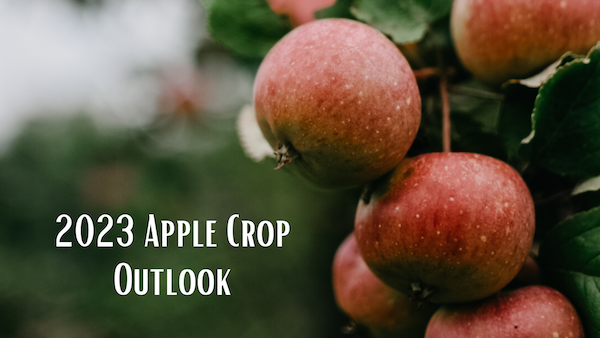
It’s time once again to share what we’ve heard from extension agents and orchardists around the country about this year’s apple crop outlook. Initial reports are from May-July of 2023.
Renae Moran, University of Maine
May 24: Temperatures were above normal going into winter, but no damage has been seen to occur from the midwinter low of -17 to -25 °F in early February. Reports from northern Maine are not yet available.
A warm spell in April caused an early start to the growing season, so green tip occurred about two weeks earlier than anticipated in southern Maine. Cool temperature followed this initial early start. Consequently, bloom occurred only one week earlier than anticipated. May 18, temperatures dropped to the lethal point during bloom and ranged from 24 to 30 °F depending on location within the state and orchard elevation. Higher elevations had better flower survival than lower spots. Western Maine had greater flower mortality, 90 to 100%, than eastern orchards, 10 to 20%.
Pollination conditions were fair, but the cool temperatures are expected to favor fruit set.
No major issues with disease or pests have occurred by this time of petal fall.
Sherif M. Sherif – Virginia Tech
June 1: The apple crop in Virginia for 2023 exhibited unique characteristics compared to previous years. One notable aspect was the early bloom, occurring approximately 10 days earlier than in 2022 and representing the earliest bloom in the past six years. This early development was likely influenced by the unusually warm winter experienced in the region. However, the early bloom was met with a series of frost events that had severe consequences for fruit trees across the state, including apples, peaches, cherries, apricots, and plums. The frost events occurred in March and April, with temperatures as low as 18°F recorded in some locations, including Winchester, VA. The damage caused by these freezing temperatures was significant, particularly affecting the apple cultivars that were transitioning from half-inch green to tight clusters. Observations collected after the first freeze on March 20th indicated severe damage to both king and side blooms, with an alarming 87% flower damage in king blooms and 60% damage in side blooms for popular varieties like Pink Lady and Gala.
Despite the detrimental effects of the frost events, the overall apple fruit crops for most cultivars in Virginia were not significantly impacted. In fact, fruit thinning applications were necessary in many parts of the state to optimize crop loads. However, the warm winter also resulted in sporadic blooming, extending over a prolonged period for certain cultivars that are not typically known for such blooming patterns, e.g. Gala. The sporadic blooming led to a unique situation where apple trees carried two distinct crops, differing in size by almost 9mm. This posed challenges for thinning decisions, particularly during the usual thinning window of 6-18mm.
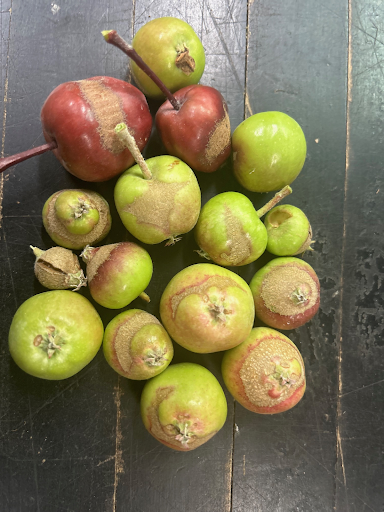
Despite the challenges posed by the frost events and the complexities in thinning decisions, it is anticipated that a full crop of apples will be achieved in most parts of Virginia. However, the quality of the fruit may be compromised in certain regions due to the frost damage (see picture attached for frost rings on apple fruits) and ineffective thinning practices. Nevertheless, operations that successfully implemented appropriate thinning strategies and employed hand thinning techniques are expected to yield above-average fruit size, particularly for cultivars like Gala, Pink Lady, and other small-sized varieties.
In conclusion, the 2023 apple crop season in Virginia was characterized by an early bloom, severe frost events, and sporadic blooming patterns. Despite the damage caused by frost, most apple cultivars are expected to produce a full crop, although fruit quality issues may arise in some areas. The challenges associated with thinning decisions due to the varying fruit sizes further added complexity to the season. However, growers who made effective thinning decisions and implemented appropriate techniques are likely to achieve above-average fruit size for specific cultivars, contributing to a successful apple crop in Virginia.
Nikki Rothwell – Michigan State University
June 22: The apple crop in Michigan is looking pretty good. We had good pollination weather, and although the winter was mild, we didn’t have any spring frost/freeze events that impacted the crop. We had good thinning weather, maybe a touch hot, but most growers had good thinning efficacy. We have been hot and dry, so growers without irrigation may struggle with fruit size. However, the weather is supposed to be cooler and have more moisture next week, so we have a long way to go to measure size. We had some cider varieties that had fire blight, more than I have seen in the past. Growers are pruning out the strikes and applying copper to keep the spread to a minimum.
Overall, growers are optimistic about apples in Michigan. We have the potential to have very high quality, and fungal disease pressure has been low because of the hot and dry weather. We are keeping an eye out for summer rots with the warm temperatures but have not seen any hint of those diseases thus far.
Jake Mann – Five Mile Orchards, California
June 27: The 2022 harvest was our biggest yet… great yield overall, and the addition of a new-to-us ranch with lots of McIntosh, Fuji, and Spitzenberg sent more fruit (and juice) to cideries throughout California. Our picking crew was fantastic, moving through the blocks quickly, while the weather remained agreeable through the fall. We seeded more acres in cover crop this year… the bell beans / vetch / peas germinated and were ready to take off when spring warmed up.
But before that… the rainfall this winter was massive. Maybe 150% of what used to be “normal” before all the drought years. We wore rubber boots for the Wassail party (not so common out here) You’ve likely seen the reports of devastation caused by flooding in nearby Pajero (a major farmworker housing community) here in Watsonville. Some corners of our orchards flooded, but fortunately drained quickly, hopefully avoiding long term damage to the trees (looks good so far). In between the storms, we accumulated plenty of chilling hours. All signs were pointing to a good year.

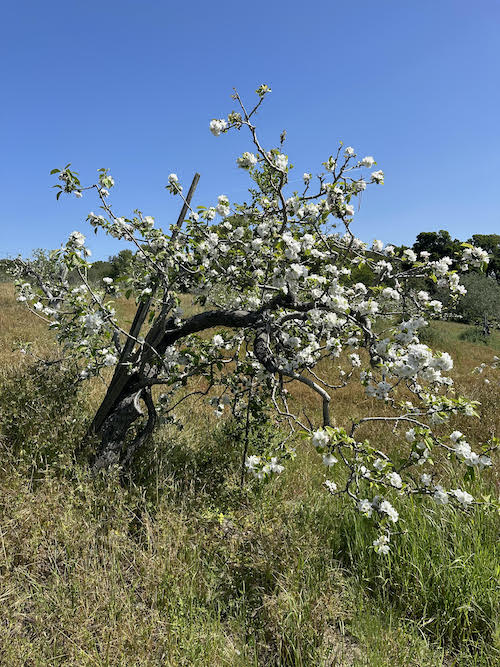
The bloom was promising in some blocks, a bit light in others. Bees were working during blossom time despite cooler temps, but as the petals fell and fruitlets started to stick, it became apparent we’re entering one of the lowest production years we’ve seen in a decade. Red Delicious (not something we use for our cider accounts) are very sparse (harvest strategy will have to be creative as our regular contract picking setup won’t pan out with the current density). McIntosh set is light but starting to size up. Pippins, Mutsu, and Fuji set is decent. Aphid has done a real number on the Granny Smith, unfortunately, and the cool temps seemed to keep lady bugs away in that crucial first week of activity. Starting to see new leaf growth beyond the aphid damage which is a relief. On a better note, the dry-farm Gravenstein orchard we take care of has the best set in the 4 years we’ve been working with it. (Good news for fans of Grav ciders).
We’ll be dialing back the irrigation efforts / hours this summer due to the accumulated rainfall. Hoping our mild, foggy weather keeps things mellow though the next couple months. Ripening is looking 2+ weeks later than normal.
Seth Brawner – WSU’s Northwestern Washington Research and Extension Center (NWREC)
April/May: This year in western Washington, spring weather was atypical – April was uncharacteristically cool and wet, while May was uncharacteristically warm and dry. Uncommonly, temperatures stayed almost completely below 60 °F until the end of April, when a heat event caused increasing temperatures (even briefly into the 70s °F) between April 27th and May 3rd. Yet overall, April was very cool. Olympia and Seattle experienced the coolest and second coolest Aprils, respectively, in the last 80 years. These low April temperatures seemed to have delayed bud development and, consequently, the date of full bloom. Hence, much of the orchard (planted with 65+ varieties) reached full bloom a little later this year, closer to mid-May rather than early May such as in the past. This will subsequently delay the time of harvest this Fall.
After an uncommonly cool April, the heat event in the beginning of May was followed by another period of cool temperatures that lasted until mid-May. These cool temperatures helped to prolong the blooming period. However, a higher heat event (high 80s °F) in mid-May and subsequent high temperatures in the latter half of May quickly reduced the effective bloom period. This May ended up being the second warmest May the Seattle area has experienced in the last 80 years. The abnormally cool, and then warm, temperatures this Spring have influenced and adjusted the full bloom date and bloom length this year. Due to the delay in bloom and subsequent high heat event which effectively ended the bloom period, these weather patterns may have a slight negative effect on pollination, fruit set, and final yields.
June: Now that we are almost into July, we can more clearly see what our crop outlook will be like this fall. While there is much variation within the orchard, this is generally the “off” year in the tree’s biennial cycle. Therefore, fruit set is relatively low compared to last season. Additionally, this year we saw the presence of tent caterpillars throughout the orchard; these pests were not present in the orchard last season. Some cultivars, those that are strongly biennial, have no fruit this season. The following list includes cultivars in which all 6 trees in the orchard had no fruit this season, or so few fruit as to be inconsequential: ‘Amere de Berthcourt’, ‘Brown Thorn’, ‘Brown’s Apple’, ‘Blanc Mollet’, ‘Breakwell Seedling’, ‘Bulmer’s Norman’, ‘Domaines’, ‘Ellis Bitter’, ‘Medaille D’Or’, ‘Mettais’, ‘Smith’s Cider’, ‘Sweet Coppin, and ‘Vilberie’. Popular cider cultivars such as ‘Golden Russet’, ‘Harrison’, ‘Hewes Virginia Crab’, ‘Kingston Black’, ‘Porter’s Perfection’, ‘Ashmead’s Kernal’, ‘Roxbury Russet’, and ‘Frequin Rouge’ all have a full apple crop load this season which needed to be thinned out. Although temperature and precipitation conditions this spring were not ideal, it seems that the apple crop load in our orchard was not severely affected. Looking forward to a great harvest this fall!
Greg Peck (Cornell University) and Scott Ramsey (New York Cider Association)
July 17: For cider apple growers in New York, 2023 was set up to be a banner year. Many orchards that had been planted over the past 10 years were finally expected to be in full production. Although the early parts of the 2022-2023 winter had above average temperatures, a relatively cold April held back bloom enough so that most regions in the state had fairly average full bloom dates. After Spongy moths, fire blight, and biennial bearing all coincided to reduce yields for many growers in 2021 and 2022, there was a tremendous bloom on cider apple trees in 2023.
Unfortunately, cold temperatures returned with a vengeance on 18 May. Most regions of the state experienced temperatures below freezing, with some locations getting into the mid-20’s. Trees in bloom or with small fruitlets experienced a range of damage from outright crop failure to varying levels of fruit loss and fruit peel damage. The damage was state-wide, but site specific. Orchards in close proximity to large bodies of water, such as Lake Ontario, one of the Finger Lakes, or the Hudson River, reported the least amount of damage. The 18 May event really drives home the importance of site selection in developing a sustainable cider apple orchard.
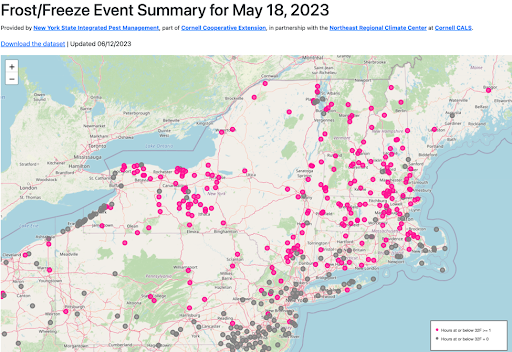
You can learn more about the frost/freeze event by visiting: https://data.nysipm.org/weather-events/20230518/map.html. This resource developed by Dan Olmstead who is the Project Lead for the Network for Environment and Weather Applications (NEWA), which is the regional mesonet system.
In response to the freeze events the New York Cider Association and Cornell co-hosted a listening session and are currently pursuing support for the cider industry through state and federal programs. Although it’s too early to fully get a sense of the varieties that fared better in the frost/freeze event, it does appear that some of the later blooming cider apples that had yet to bloom will have at least a partial crop.
To date, there hasn’t been a statewide survey for the apple industry at-large, much less for cider apple growers, there will still be many apples available for cider production. In fact, fresh-market apples that are unsellable through mainstream markets because of peel blemishes can still be used for cider production.
After the 18 May event, much of the state experienced dry conditions through the end of June, and then frequent precipitation occurred for the last few weeks. In mid-July, parts of the state experienced a “once in a thousand years” rain event that caused widespread damage to crops and infrastructure. It is too early to comment on the effects this will have on apple production, particularly in the Hudson River Valley where 8 inches of rain was reported in just six hours.
Additionally, smoke from fires in Quebec, British Columbia, and elsewhere have caused repeated air quality issues in New York. Although there might be some reduction in photosynthesis from the smoke, there should be minimal impact on apple productivity or fruit quality. However, the smoke is a significant health hazard for farm workers.
Despite the hardship that these weather and largely climate change driven events have on individual farms and cider producers, there are many producers in the state that have reported having minimal damage. In particular, growers close to Lake Ontario, one of Finger Lakes, or the Hudson River Valley have so far been spared significant crop damage. Even though crop yields and cider production will be down this year, we are hopeful that 2023 will produce some excellent New York ciders.
Megan Muehlbauer – Rutgers University
July 31: The 2023 growing season has been very variable across New Jersey. A late season frost caused extensive damage to the apple crop in the Northern half of the state. However, many growers unaffected by the frost are anticipating a bumper crop.
The season kicked off with very little rain, and by mid summer the state had a number of heavy rain events.
Thus far diseases have been minimal or well controlled.
CCP Level One Workshop at Far West Cider
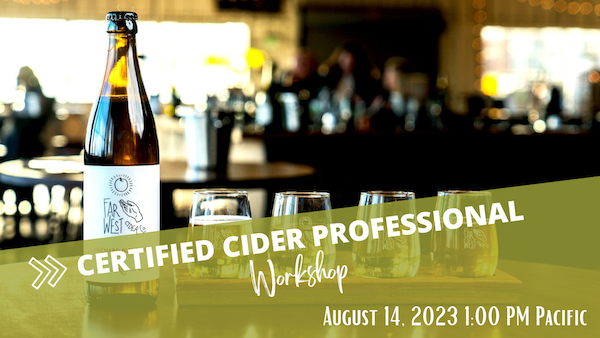
Far West Cider is excited to collaborate with the American Cider Association to host an in person Certified Cider Professional workshop on the afternoon of August 14!
Do you sell cider or work in a tasting room or retail shop? Are you a chef, sommelier, cicerone, buyer or cidermaker? Do you just love cider and want to be able to spread the word with some serious cider knowledge to back it up? Then this workshop is perfect for you! This is a great opportunity to gather with fellow California cider folks to develop your cider knowledge so you can keep on promoting the amazing California ciders you know and love or to learn about them if you’re new to cider! Not to mention, you’ll have the chance to walk away with a Certified Cider Professional Level One designation!
Attendees will enjoy a two hour workshop and tasting session with American Cider Association Education Operations Manager and Certified Pommelier™ Jennie Dorsey. After the workshop, attendees will have the opportunity to take the online test at Far West Cider (bring your own computer). The test can also be taken online at a later date if so desired.
Did we mention that after the workshop, you’ll be able to purchase Far West Cider to take home or to enjoy with fellow attendees in the tasting room?!
Cost to attend is $65 per person and includes the test fee (this is a $30 savings from individual bundle purchases AND includes a cider tasting).
*A note about arriving at Far West Cider: Use the above address in Google Maps and just follow the navigation, if it feels like you’ve headed the wrong way you’re right on track. Riggers Loft is located at the end of the long winding road. Look for a building marked “SHEET METAL / PAINTING” and a red banner marked “WINE TASTING HERE.” Far West is right inside!
CCP In Person Training at South Hill Cider
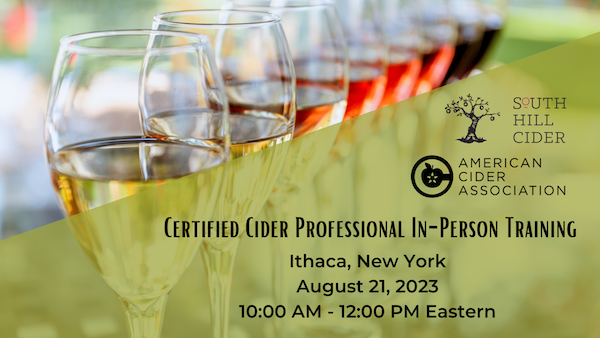
South Hill Cider is excited to collaborate with the American Cider Association to host a training workshop in person for the Certified Cider Professional Level 1 Certification at their cidery on August 21, from 10:00 AM – 12:00 PM Eastern. Participants will have the opportunity to take the test online immediately after the training or take the test at a later date.
This is a great opportunity for the NY cider community to gather in person to attend the workshop and get CCP Level 1 certified. Anyone who sells cider, works in a tasting room or retail shop, is an owner, chef, sommelier, cicerone, buyer or cidermaker who is interested in cider education and adding a cider certification to their accreditation is welcome and encouraged to join the training session!
Lunch will also be available for purchase at the South Hill Cider tasting room after the training.
Details :
- 9:45 AM: Arrival and check-in
- 10:00 AM – 12:00 PM: Workshop in tent
- 12:00 PM – 12:45 PM: Lunch break (food will be available to purchase)
- 1:00 PM – 2:15 PM: Take the online CCP 1 exam (please bring your own laptop)
- 2:15 PM: Enjoy a glass of cider and the view
Cost per person is $45 which includes the test fee. Tickets are available on EventBrite.
Interested in learning how you can host an in-person training event at your location? Learn more on our CCP Level 1 website.
Crack the Code: Your Guide to Finding Dry Cider in the Supermarket
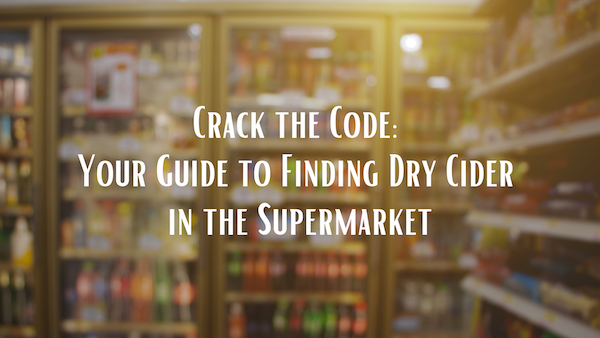
Ready to get in on the fun this Dry Cider July? Let’s talk about the best ways to find dry cider at the supermarket. With a plethora of options from fruity summer flavors, botanical ciders, and distractingly beautiful labels, it can be hard to determine which ones are dry. Thankfully, there are some telltale signs whether the cider that’s caught your eye is dry or not.
First, let’s talk about the difference between dry vs. sweet cider labels. Ciders in the U.S. are labelled based on their residual sugar, and fit into one of four categories: Sweet, Semi-Sweet, Semi-Dry, or Dry. This month celebrates the driest of the dry. Dry ciders have 0 grams of sugar and what we’ll be focusing on. We’ll also touch on semi-dry ciders if that’s more your speed. It still counts on the ‘gram. So, how to choose? Here are four strategies to determine whether or not a cider is dry.
Cider Name or Subtext
On the face of the cider, the can or bottle should have a name. If the name or subtext includes dry, semi-dry, off-dry or brut, we’re on the dry end of the spectrum. Conversely, if we find sweet or semi-sweet listed, we can eliminate those options.
Brut aside: Brut is a style of cider modeled after the French Brut Champagne. Cideries take different approaches to honor this beverage’s French origin by means of aging the cider on French wine barrels or using champagne yeast. What all Brut ciders have in common is their sparkling nature and zero grams of residual cider.
Cider Descriptors
Another way to tell if the cider in your hand is dry is to spin the can around and look for descriptors provided by the cidery. Many cideries provide a brief description of the cider, highlighting tasting notes and how to best experience it either temperature-wise or with food pairings. Some cideries go above and beyond by providing a sweet-to-dry sliding scale, denoting where this particular cider falls.
Sugar Content
If the other two methods haven’t brought you an answer yet, another option is to check the nutritional facts. This method can be unreliable as nutritional facts are not universally required for cider. However, if the nutrition facts are available, check how many grams of sugar are in the can. Generally, if there are 0-3 grams of sugar in a 16 oz can, you are squarely in dry country. If you’re more in a semi-dry mood, look for 4-10 grams of sugar.
Earlier this month in the ACA blog, Tim Godfrey highlighted that a dry cider might not taste dry after all. My favorite examples of this phenomenon are fruit ciders and ciders featuring the McIntosh apple. Fruit ciders bring their own character to the table and the fruitiness can trick our brain into thinking a cider with 0 grams of sugar is a sweet cider. Similarly, McIntosh apples are flamboyant, botanical apples that bring what our brains interpret as sweetness to the drink. These ciders can provide a different kind of dry cider experience.
Zero (or no) Sulfites
This final strategy to determine if you have a dry cider is a tried but not always true method. Look to see if the can lists zero (or no) sulfites. The addition of sulfites is a common method to stop the cider’s fermentation process before the cider is fully dry. If the cider lists that it is sulfite-free, you most likely have yourself a dry cider. Many cideries let their cider go completely dry to negate the need for sulfites. Because sulfites are a method of halting fermentation before a cider is fully dry, their presence likely indicates a sweeter cider. Note that some cideries may choose to add sulfites to their dry cider as a precautionary measure.
Whichever method you choose to follow here, listen to your gut. What sounds good to you? What flavor profile will appeal to your friends at the bottle share? And, if you follow these tips to your next favorite dry cider, let us know on Instagram using #dryciderjuly and #pickdrycider. Cheers!
Want a cheat sheet for dry cider near you? Check out our Dry Cider Finder!

Alexsis Cassady is a cider influencer and Certified Pommelier™ who can be found on Instagram @ciderminded.
Delicious Cocktail Concoctions for Dry Cider July
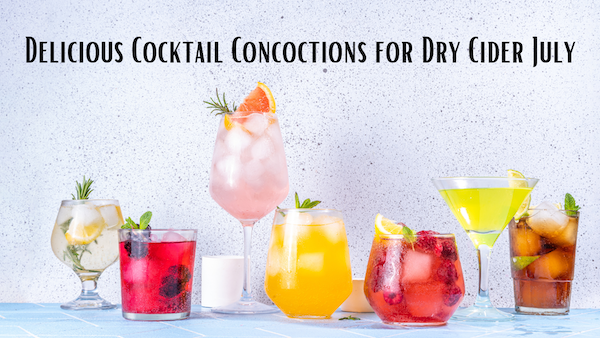
Summer is my favorite time of year for cocktails, from lazy beach days to backyard barbecues, or just relaxing under the warm sun, every activity is ripe with cocktail possibilities. It doesn’t hurt that we are surrounded by fresh juicy berries, crisp veggies, and citrus galore. I can think of no better way to enjoy the bounty of the season than to create dry cider cocktails for any palate.
Basic Rules for Cocktails
When it comes to creating your own cocktail recipes, there are a few basic rules that can really up your game.
- The 3 Ingredient Formula: Classic cocktails tend to follow a similar and reproducible 3 “ingredient” formula. Base liquor, ingredients to add sweetness, acidity, or both, and then your extras. The goal of the 3 ingredient formula is to create the perfect trifecta of balance and to be a building block for endless cocktail variations.
- Ice: Should your drink be shaken, stirred, or built? Should your drink be served up or on the rocks? The accepted “rule” is to shake if there is citrus in the cocktail, and to stir if the cocktail is spirit heavy. Built cocktails, also known as mixed drinks tend to be one liquor and one mixer with no added acid or sweet ingredients.
- Ratios: As for ratios, I like to start by considering the “golden rule” or 2:1:1. That is 2 parts spirit to 1 part sweet and 1 part sour. While I do use the word “rule”, I do say that with a grain of salt. These are more guidelines than hard and fast rules and are meant simply as a starting point for your cocktail constructions.
How Dry Cider Fits In
Now that we have our basic cocktail formula down, we can start to piece in cider to our formula. There are a few basic parameters to help in choosing just the right cider.
First, we can break any cider down into its base components: Sweetness/ Acidity/ Tannin
Because we are looking for cocktails using only dry cider, that leaves us with the following 4 categories.
- Dry high acid, high tannin
- Dry low acid, low tannin
- Dry low acid, high tannin
- Dry high acid, low tannin
Along with these categories, be sure to also consider fruitiness or perceived sweetness in the cider.
Next, we can break a cider down even further into basic mouthfeel and flavor categories. This would include whether it is still or sparkling, barrel aged or not. We could even dive as deep as pinpointing its most expressive flavor elements, but to be honest, we don’t even need to go that far to make delicious cider cocktails.
Now we have our basic cocktail rules and we have our basic cider components we can start to construct some delicious cocktails. I started my list by venturing out to the local farmers market. I was struck by the number of delicious fruits, berries and cucumbers and even fresh eggs that caught my eye. This was the inspiration for these true summer cocktails.
White Linen a.k.a Cucumber Gin Fizz
This cocktail is a refreshing crowd pleaser.

- 1.5 oz. gin
- .5 oz. St. Germain
- Cucumber
- Fresh lemon juice
- .5 oz. simple syrup
- Saline spray (optional)
- Top with a dry floral cider
- Cucumber ribbons for garnish
Muddle cucumber in a shaker, add gin ( I like Hendricks in this application), St. Germain, simple syrup, and fresh lemon juice. Add ice, shake well and double strain
Upstate New York Sour
Elegant and beautiful, this twist on a classic cocktail is sure to please.

- 2 oz. bourbon
- .75 oz. simple syrup
- 1 oz. fresh lemon juice
- 1 egg white
- 1.5 oz. dry tannin forward cider
- Bourbon-soaked cherries for garnish
Add bourbon, simple syrup, lemon juice and egg white (or vegan foamer) to a shaker and dry shake to incorporate all the ingredients and achieve a nice foamy texture. Add ice and wet shake. Strain into a rocks glass and add a large ice cube. Using the backside of a bar spoon, float 1.5 oz of your favorite dry tannin forward cider.
Summer Cider Sangria
Looking to make a large batch cocktail that you can adjust ingredients based on what you have on hand? This is the perfect cocktail for any summer plans.
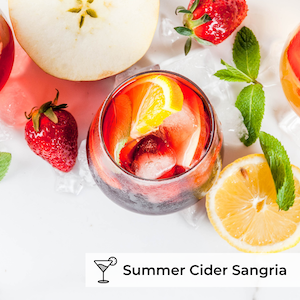
- 750ml dry cider
- ½ cup apple or pear brandy
- Apple or pear slices
- Fresh berries
- Fresh citrus
- Citrus round and mint or other fresh savory herbs for garnish
Combine your fresh fruit and cider of choice into a large pitcher and stir to combine. Once satisfied with the fruit infusion, add the brandy and lots of ice. If you prefer your sangria to be a little sweeter, add fresh juice or lemonade.
*Note: you can change up the fruits used to better suit your cider choice. If your cider is low in acid, you could use more citrus. If your cider is higher in tannin, you could use more juicy red fruits to balance.
Not sure which cider to use, check out the American Cider Association’s Dry Cider Finder for a fantastic list of dry ciders throughout the US.
Help Us Tell Cider’s Story: Take ACA’s 2022 Cider Production Survey
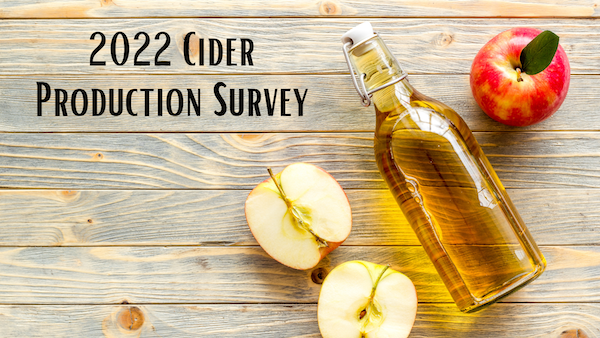
At the American Cider Association we work hard to support cider and cidermakers across the United States every day of the year, but we need your help to keep providing Congress, the media, and buyers with the most up-to-date and complete industry overview we possibly can. Please help us collect aggregated production information for the U.S. cider industry for 2022.
If you are licensed to make cider on a commercial basis we invite you to take our survey so we can gather information vital to promoting and protecting cider in the U.S.
Details:
- This survey will take about 20 minutes to complete.
- The survey is being aggregated and anonymized by an independent third party. They have agreed to not share information with us that might identify who you or your cidery are, and to only share aggregate data with us. YOUR PRIVACY MATTERS TO US.
- Your cidery name is collected by the 3rd party to ensure there are no duplicates, but the ACA will not store that information after the survey has been returned to us with identify features removed.
- We do ask a number of questions about sales and production for 2022. You will find it helpful to have that data handy before completing the survey.
- Note: If you produce wine or other beverages besides cider, please answer only considering your cider production.
- Deadline to complete the survey is August 10, 2023.
- Anyone who submits their completed survey and provides their contact info will be entered into a raffle to win an American Cider Association hoodie (4 available) and a grand prize winner will receive a complimentary ticket to CiderCon® 2024!
If you have any questions regarding this survey or how the data is used, please contact CEO of the American Cider Association Michelle McGrath.
We appreciate your help in allowing us to continue to promote cider across the United States!
Why Does My Dry Cider Taste Sweet?
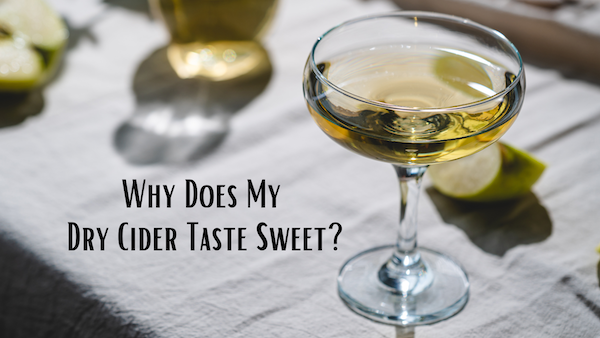
Written by Tim Godfrey
Cider has long dealt with assumptions and misrepresentations of sweetness. In fact, the first reaction when folks are asked about cider often relates to the question of how sweet it is. Curiously, this happens in cases where the cider is actually quite dry, but is adamantly proclaimed as sweet. Why is this?
In the realm of tasting and sensory evaluation, the distinction between perceptive sweetness and residual sugar presents a captivating conundrum for Pommeliers, industry professionals, and even the average drinker. These terms, though seemingly interchangeable, unveil distinct concepts that significantly influence our sensory experience. Perceptive sweetness encompasses the remarkable interplay of our taste buds and olfactory receptors, enabling us to perceive sweetness in a cider despite the absence or minimal presence of residual sugar. It is an intriguing phenomenon that relies on the intricate complexities of sensory perception. Our brain’s ability to deceive us becomes apparent as taste and aroma interact, conjuring a perceptual illusion of sweetness, even in ciders with restrained residual sugar content. This phenomenon is typically attributed to three other sensory characteristics of cider: Aromatics, Acidity, and Alcohol.
Aromatics
Ciders contain a vast array of aromatic compounds derived from various sources, including the apples themselves, fermentation, and aging processes. Fruity aromas, such as those reminiscent of ripe apples, citrus or tropical fruits, or any added fruit to the cider can evoke associations with sweetness, that we generally term “fruitiness”. Even in the absence of substantial (or any) residual sugar, the presence of fruity aromas can trick our senses into perceiving a cider as sweeter than it actually is. The same is true of ciders aged in oak barrels, which can contribute flavors such as vanilla, caramel, or spices. These additional aromas interact with the fruit character and create a sense of sweetness on the palate even when no sugar is present. This is likely due to the close link between the olfactory receptors in our noses that perceive these fruity aromas, and the taste buds on our tongues that perceive sweetness. Knowing how something will taste based on how it smells is anatomically connected as well. The olfactory receptors perceive aromas through two pathways: directly through the nose – “orthonasal”, and through the back of our throat – “retronasal”. This is all to say that our sense memories of fruit as “sweet” is complicated by the anatomy of aroma perception, creating perceptive sweetness when sugar might not actually be present.
Acidity
Our taste buds perceive five basic tastes, all of which interact and counteract each other in differing, complex ways. Acidity and Sweetness are two of these that tend to have a counteracting relationship and are foundational in our perception of cider. Acid tends to provide a light, refreshing quality to cider, whereas sweetness contributes viscosity and body. Balance is achieved when these two sensations are in harmony, but given their counteractive nature, the interaction between sweetness and acidity can influence our perception of residual sweetness. For example, high acidity tends to mask or diminish the perception of sweetness, resulting in a lighter, crisp body, whereas ciders with low acidity and high residual sugar can result in a cloying, syrupy sweetness, and “flabby” body. An overly sweet cider can be “fixed” with the addition of acid and vice versa, but this can be hard to discriminate as a taster. In cases where it is unclear whether or not real sugar is present, rely on your tongue to feel the texture of the cider rather than the taste.
Alcohol
Frankly, at the regular ABV of most ciders (5-8%) alcohol does not seem to bring the same perceptive sweetness impact as it does in wine. However, it is well known that the presence of alcohol in wine can amplify the perception of sweetness, and that premise could still apply to cider to a degree. Alcohol stimulates our sweet taste receptors, intensifying our perception of sweetness even in the absence of substantial residual sugar. This interaction between alcohol and our taste buds creates an intriguing sensory experience that can deceive our palate. Alcohol also contributes to the overall balance and integration of flavors in cider. It adds body, texture, and warmth to the cider, complementing other sensory elements. When combined with residual sugar, alcohol can create a perception of sweetness that is greater than the actual sugar content would suggest. Alcohol’s impact on body and texture also influences the mouthfeel and viscosity of cider. Higher alcohol levels impart a fuller, more viscous texture, which is similarly experienced in sweet ciders. So while the impact of alcohol on perceptive sweetness may not be as exaggerated in cider as it is in wine, it undoubtedly still plays a role.
How do we overcome the mind games of perceptible sweetness versus residual sugar in cider? Consider these five tips when assessing a cider:
- Analyze the Label: Look for terms such as “dry” or “off-dry,” which indicate lower residual sugar levels. Style can also impact residual sweetness. If the cider was carbonated using a secondary fermentation, chances are it is dry. In some cases you might be able to consult the Nutrition Facts label, so take a look to see if the cider has added sugar.
- Assess Acidity: Evaluate the cider’s acidity level. Higher acidity levels can counterbalance residual sugar, resulting in a drier taste perception. Ciders with a pronounced acidic backbone are more likely to exhibit perceptive sweetness rather than substantial residual sugar.
- Evaluate Mouthfeel: Pay attention to the cider’s texture and viscosity. Ciders with a thicker or syrupy mouthfeel often correlate with higher residual sugar levels. On the other hand, ciders with a lighter and more refreshing mouthfeel are more likely to convey perceptive sweetness without significant residual sugar.
- Consider Alcohol Content: Take note of the alcohol level in the cider as indicated on the label. Higher alcohol concentrations can enhance the perception of sweetness. Even in the absence of residual sugar, ciders with elevated alcohol content may impart a perceived sweetness due to the stimulation of sweet taste receptors.
- Trust Your Palate: Ultimately, building a discerning palate takes time and experience tasting ciders. Keep on tasting! Looking for dry ciders to try? Check our our Dry Cider Directory!

Tim Godfrey has been involved in the cider industry for over ten years, making cider commercially in the Midwest as well as on the West Coast, and has volunteered for the American Cider Association since 2019. Tim currently works at Lake Michigan College in Benton Harbor, MI in the Wine and Viticulture Program, running the teaching winery and instructing enology coursework. He continues to stay involved in the cider industry through the ACA, as a consultant to startup and emerging cideries across the U.S. through his business Godfrey Beverage Solutions, and as a home orchardist and cidermaker. He is also a Certified Pommelier™.
New On Premise Data for ACA Members!

Nationally Cider is up 3.3% in On Premise channels for the 52 week period ending April 23, 2023.
That’s right! On Premise data is back! We have renewed our partnership with CGA by NIQ OPM to bring our members helpful insights about On Premise cider trends. Drill down by Chain or Independent establishments, by 6 major urban markets, by national/regional brands, and by draft/package. Compare current trends to data from the last couple years to see growth and opportunities.
You must be an active ACA member to view this data. Not a member? Join now! Need to renew your membership. Renew here!
Live Sensory Analysis Webinar with Alma Cider
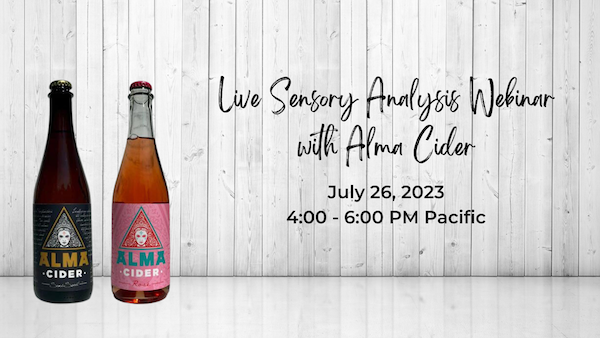
Join our Certified Pommelier™ panel in a live practice sensory webinar on Wednesday, July 26, 2023 from 4:00-6:00 PM Pacific featuring cider from Alma Cider. This webinar will also be available to rewatch and practice as a prerecorded event. ACA Members can register for a discounted rate of $15. The discount code for members can be found here.
Cider must be purchased separately. Please be aware that it may take several days to receive your cider order, so we encourage you to purchase your ciders as soon as possible. Also, please verify that cider can be sent to your state before purchasing ciders. Ciders can be purchased from Press then Press.
Once registered, you will receive a confirmation email. This email is a placeholder for the event. The evening before the event you will receive an email with a Zoom link to the webinar. Please note this link will be sent to the registered email.
Certified Pommelier™ Exam to Be Held in San Francisco August 13
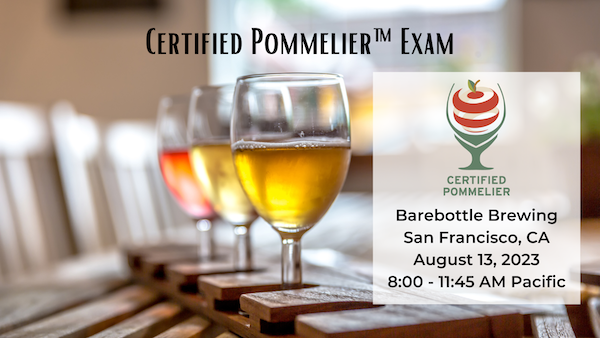
TAKE THE CERTIFIED POMMELIER™ EXAM IN SAN FRANCISCO, CALIFORNIA!
Are you ready to take the next step in your professional development in the cider industry? Already passed the Certified Cider Professional Level 1 Certification and looking for that next challenge? Now’s your chance!
The American Cider Association is pleased to announce that the next Certified Pommelier™ Exam will be held in San Francisco, California! The exam will take place Sunday, August 13, 2023 at Barebottle Brewing, 1525 Cortland Ave, San Francisco, CA 94110.
After the exam you can stick around for a tour and tasting at Barebottle Brewing too!
PREPARING FOR THE CERTIFIED POMMELIER™ EXAM
The Certified Pommelier™ Exam is our second tier of certification and requires in depth study. You must have passed our CCP Level One Certification prior to taking the Certified Pommelier™ Exam. You can purchase a CCP Level One bundle here. (ACA members can find a discount code to purchase the bundle here). The bundle includes an on demand training webinar, a study guide, and two exam attempts.
The ACA has also recently released a Certified Pommelier™ Study Guide that covers the information needed for the theory portion of the exam. It can be purchased here on Amazon.
In addition, several pre-recorded sensory webinars are also available for purchase and can be found here. Please be aware that cider must be purchased separately. Also, be aware that key sensory elements of these ciders may vary from year to year.
Stay tuned for the option to participate in a live sensory analysis webinar this summer prior to the exam in San Francisco. You can check our certification page for the latest news.
WHILE YOU’RE IN SAN FRANCISCO
Why not make it a weekend (or longer) since you’ll be heading to the beautiful Bay Area of California anyway, especially since it’s the weekend of the Gravenstein Apple Fair, which will be celebrating it’s 50th year!

